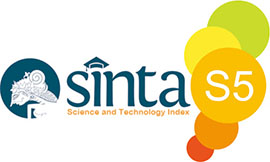Peran Keluarga, Sekolah dan Masyarakat dalam Penanganan Kekerasan Terhadap Anak (Child Abuse) pada Masa Pandemi COVID-19
 ),
), (1) Universitas Negeri Padang
 Corresponding Author
Corresponding Author
DOI : https://doi.org/10.24036/et.v8i2.110999
Full Text:
 Language : en
Language : en
 Language : en
Language : en
Abstract
This paper is based on the problem that there has been an increase in violence against children during the pandemic of the corona viruse desease-19 which is popular with covid-19. The review begins with the development of Covid-19 in Indonesia and the world and is continued with Covid-19 on violence perpetrated by the environment against children. Children are entrusted by the Almighty who must be cared for and considered for their growth and development. It is not uncommon for violence against children from adults to be broadcast on mass media or social media in the form of physical violence "physical abuse" and "physical abuse" psychological violence. There are three places where violence against children occurs, namely: 1) household; 2) schools, and 3) communities. In each of these areas, violence can be committed by children of the same age, older children, adults, or people with mental disorders. It is the duty of all parties to take precautions against violence or to take measures against them if violence has occurred. One of the agencies in Indonesia that tackles violence against children is the Indonesian Child Protection Commission (KPAI). During a pandemic, the government issued a “General Guidelines for Child Protection for Handling Covid-19” which contained, among other things, 1) every child has the right to protection and clear information about the prevention and transmission of Covid-19; 2) protected from all forms of violence, exploitation, neglect, mistreatment and TIP; and 3) Ensuring psychosocial, health, education and privacy guarantees for children. If it is related to the pedagogical function, it is very urgent to educate everyone who is in the three realms of causes of violence in children during the Covid-19 period.
Keywords: Covid-19; Violence in Children; Prevention; pedagogical function.
References
Adawiah, Rabiah Al. 2015. Upaya Pencegahan Terhadap Anak. Jurnal Keamanan Nasional. Volume 1, Nomor 2 (hlm.287-288)
Anggraeni, Ratna Dewi dan Sama’I. 2013. Dampak Kekerasan Anak dalam Rumah Tangga. Artikel Ilmiah Hasil Penelitian Mahasiswa: Universitas Jember. Volume 1, Nomor 1 (hlm.2)
Hasanah, Uswatun dan Raharjo, Santoso Tri. 2016. Penanganan Kekerasan Anak Berbasis Masyarakat. Share Social Work Journal. Volume 6, Nomor 1 (hlm.91)
Maknun, Lu’luil. 2017. Kekerasan terhadap Anak yang dilakukan oleh Orang Tua (Child Abuse). Muallimuna: Jurnal Madrasah Ibtidaiyah. Volume 3, Nomor 1 (hlm.76)
Odhayani, Abdulaziz Al; Watson, William J; Watson, Lindsay. 2013. Behavioural Consequences of Child Abuse. Canadian Family Physician. Volume 59 (hlm.836)
Praditama, Shandi; Nurhadi; Budiarti, Atik Catur. 2015. Kekerasan terhadap Anak dalam Keluarga dalam Perspektif Fakta Sosial. Journal of Sociology-Anthropology Education: Universitas Sebelas Maret (hlm.7-8)
Probosiwi, Ratih dan Bahransyaf, Daud. 2015. Pedofilia dan Kekerasan Seksual: Masalah dan Perlindungan terhadap Anak. Jurnal Sosio Informa. Volume 1, Nomor 1 (hlm.31)
Saraswati, Putu Sekarwangi dan Susrama, I Nengah. 2020. Peran Perempuan dalam Keluarga untuk Melindungi serta Pemenuhan Hak Anak Dimasa Pandemi COVID-19. Prosiding Webinar Nasional Universitas Mahasaraswati 2020 (hlm.134-136)
 Article Metrics
Article Metrics
 Abstract Views : 1393 times
Abstract Views : 1393 times
 PDF Downloaded : 289 times
PDF Downloaded : 289 times
 PDF Downloaded : 28 times
PDF Downloaded : 28 times
Refbacks
- There are currently no refbacks.





